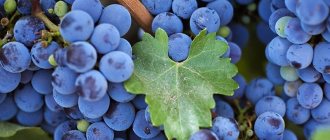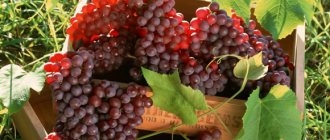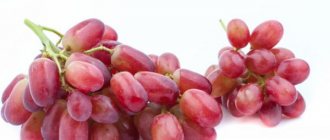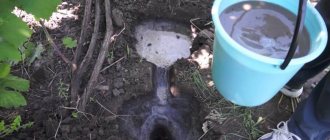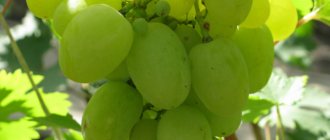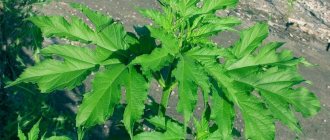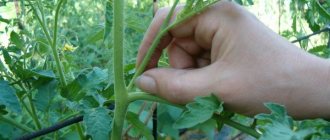Fruits and berries » Grapes
0
2745
Article rating
Kira Stoletova
The flowering of grapes is a special period that determines the quantity and quality of the future harvest. How many ovaries the grapevine will produce depends on how correct the care was at the stage of formation and opening of buds.
Caring for grapes during flowering
Characteristics and description of flowering
In most cases, grapes begin to bloom in late spring at temperatures between 25-30 degrees. However, certain varieties also bloom at lower temperatures, depending on the region. European grape varieties, accustomed to mild climates, simply do not fertilize at low temperatures.
An important feature is that the weather must be dry. Also, you should not water the grapes during flowering and a few days before it. Rain at this time is very harmful for the plant, because it washes the pollen from the inflorescences and there may be no harvest. In case of rain, artificial pollination should be carried out (if the vineyard is small in size).
The flowering process lasts only a few hours in the morning, since at this time the conditions are most suitable for this. The rest of the time the buds are closed. Although some flowers may bloom late. The entire fertilization period lasts from one to two weeks.
The number of ovaries is greatly influenced by weather and soil. If the soil is poor in nutrients and mineral components, then the clusters will be small and in small quantities.
Wind, like rain, can harm the flowering process because it blows away pollen and can tear off flowers. That is why grapes need to be protected and helped during this period; everything that depends on a person must be done for their successful pollination.
Causes of problems
There are many factors affecting the crop that reduce its yield. All the reasons that affect the ovary of grape flowers and lead to their death can be divided into 2 large groups: natural and unnatural.
Natural causes include:
- Unfavorable climate. Why grape inflorescences wither and rot: frequent rains, scorching sun, strong wind. Also, heavy rains and low temperatures lead to pollination problems. Due to abundant moisture, pollinated flowers fall off, and the ovary begins to rot and die.
- Plant age. Every vineyard knows that the grapes are very weak in the first few years after planting. The crop spends all its energy on strengthening the root system, which is why problems arise with the formation of berries. The plant also weakens with age; the crop produces a good harvest within 8 years after planting. After this period, the bush begins to weaken, flowers cannot form and the bush stops blooming altogether.
- Weak bush. Some bushes are weak on their own, and even good care does not help strengthen them. Flowers rarely form on such bushes, and if they begin to bloom, they simply fall off.
- Pests. The most common reason why grapes fall off is pests. There are 800 species of insects (mites, aphids, caterpillars, thrips, beetles) that harm this crop. Insects suck the juices from the plant, which causes a weak vine. Also, many insects feed on buds, ovaries and developing berries. Sometimes the flowers on the brush don’t even have time to bloom. In addition to insects, rodents cause harm to grapes. In winter, the crop is covered to prevent it from freezing, and mice build nests there. Over the winter, they eat the bark and damage the branches, causing the bush to weaken and dry out.
- Diseases. Shedding of the ovary of diseased grapes occurs due to weakening of the plant. You can find out that the cause of the death of flowers was a disease by looking at the leaves. Leaves change color and curl. However, the same signs occur when the plant is exposed to pests. Therefore, before taking action, you should carefully examine the plant.
These are the main reasons that do not depend on care. In addition to the above, this list can also include the lack of pollination, unsuitable soil, and characteristics of the variety.
Unnatural causes include:
Excess or lack of fertilizers. To increase the yield of any crop, you need to periodically enrich the soil. Lack of nutrients is the main cause of barren flowers. An excess of fertilizer is also harmful, as it causes flowers to fall and rot. Frequent use of chemicals. A chemical drug is not always beneficial. Too frequent treatment against pests and diseases leads to the fact that the ovary deteriorates and falls off during the formation of fruits. Incorrect stepsoning. To get a good harvest, you need to get rid of excess leaves and vines
It is important to carry out pinching at a precise time; you also need to know which branches need to be removed. All this depends on the characteristics of the plant species
If the procedure is carried out incorrectly, problems with flowering will arise. Lack of watering or excess moisture. Why grapes fall off immediately after flowering: lack of moisture or its excess. If the plant does not receive enough moisture, it will become a barren flower, the ovary will dry out and fall off. Excess moisture generally causes flowers and developing berries to darken and fall off. Damage to the vine. This weakens the plant and affects its productivity. The grapes on the damaged vine dry out and fall off.
Unnatural causes are improper care. Therefore, if the gardener did not immediately learn the rules for caring for this crop, then he should not ask the question: why the ovary on the grapes crumbles and the berries do not form, because the answer is obvious.
Cissus: can you keep it in the house - useful properties and signs
Thanks to the high bacterial and phytoncidal activity of the indoor flower, the atmosphere in the home is cleansed. Microcomponents released by cissus kill bacteria that cause allergic diseases and gastrointestinal disorders.
Decorative vine perfectly humidifies the air in the room and absorbs excess dust.
Helps get rid of formaldehyde - fumes from building materials, which often cause headaches, provoke nausea, and irritate the respiratory system.
Several pots of plants in the room increase vitality and reduce fatigue.
Popular signs and superstitions associate the cissus flower, like most lianas, with a muzhigon flower, that is, the flower is capable of surviving a spouse from home. Whether or not to keep hanging plants at home is up to everyone to decide for themselves; most flower growers do not pay attention to these myths.
Beneficial properties of wild grapes
Apart from creating spectacular design solutions, the plant does not bring much benefit. Although the leaves contain large amounts of vitamin C.
A decoction of the leaves can be used to treat poor blood clotting. Berries contain substances that help cope with inflammation.
However, the ornamental vine is not widely used for medicinal purposes. So it's better to use more traditional plants.
Here they are, wild grapes, the planting and care of which is particularly simple, and the beautiful leaves can create a charming hedge almost anywhere.
Preparing the plant
In order for the grape bush to safely survive the period of flowering and pollination, it is necessary to follow certain preparation recommendations.
- In early spring you need to form bushes. To do this, you need to tie the shoots to the frame and cut off unnecessary ones. Adjust the branches so that future clusters have access to the sun, but do not overdo it.
- Before flowering, regularly water the grapes generously and complete all water procedures in about a week.
- The plant should also be fertilized a few days before pollination begins. A trace element that has a positive effect on grapes is boron. Therefore, you can use preparations and fertilizers that contain this component.
- You can spray grapes against diseases and pests 4-5 days before pollination begins. The finished composition must be diluted in water according to the instructions and the bush should be completely irrigated.
- In vigorously growing bushes, it is necessary to cut off excess inflorescences in order to remove excess load from the shoots and so that more nutrients are supplied to the remaining clusters. You also need to trim the inflorescences on bushes that bear fruit for the first time.
Preparing for flowering
The grapes need to be prepared before flowering so that the process is as fruitful as possible. For this purpose, a number of preparatory activities are carried out in the spring:
Formation of bushes. At this stage, it is necessary to trim off the excess green parts. It is also worth staking young shoots, which really need a frame in the spring. As for older shoots, they should also be inspected and their placement adjusted if necessary
It is important to ensure a comfortable position for the plant so that the sun has access to the bunches. In addition, it will be more convenient for the gardener to care for the vineyard.
Watering
Grapes in the spring season really need regular watering. By ensuring this, you can avoid the appearance of cracks in the berries in the future when there are rainy days. A very good option would be to spray with a boron solution, which will have a very positive effect on the plant and will certainly affect the quality development of the grape crop. Caring for inflorescences. This procedure usually applies to those grape varieties that bear fruit in large clusters. The bottom line is that on the shoots that will bear fruit, only one, the most promising bunch is left, and the rest are manually removed. In this way, you can relieve the vineyard from excess loads.
Protection from pests and diseases. To do this, you need to spray the vineyard about 3-5 days before the flowers on the crop begin to bloom. You can use the drugs “Topaz”, “Decis” and “Ridomil Gold”. It is enough to dilute them with water and completely spray the bush.
The preparation procedures are very simple and do not take much time, but they will definitely have a positive effect on the yield of this crop.
Did you know? In Spain and Portugal, there is a New Year's custom according to which you need to eat grapes at the last minute of the passing year. At the same time, with each chime, 12 grapes are eaten and at the same time 12 wishes are made.
Flowering grapes
The flowering period of grapes in different regions begins in early May and lasts until the end of June. Flowers in inflorescences open gradually one after another over 1-3 weeks. Grape clusters bloom several hours a day. Most flowers bloom from 6.00 to 11.00. After the bud has fully opened, the stigmas remain receptive to fertilization for 4 to 6 days. Fertilization lasts for one day, and then the stage of ovary formation begins.
You can expect a good harvest if the flowering vineyards are not flooded with rain or scorched by the sun. The most comfortable temperature for pollination and ovary formation is 25-30°C.
Grape fruits
In regions with a cold climate, where the air temperature does not rise above 16°C, the flowering of vineyards is sluggish. In such conditions, the flowers of a heat-loving plant do not open well, and their pollination is difficult. Cold climate negatively affects the formation of ovaries in inflorescences.
Large amounts of pollen and flowers are produced on vines that receive sufficient nutrients. Vineyards growing on depleted soils bear fruit poorly.
Important! Cold gusty winds can cause a poor harvest. Therefore, areas are allocated for vineyards, protected on all sides from drafts.
Stages and timing of flowering
After the first flowers in the clusters shed their corollas (caps), we can assume that the grapes have bloomed. The brushes located close to the ground begin to bloom first. Miniature flowers, collected in a cluster, bloom from the bottom of the cone-shaped inflorescence.
The flowers open slowly at the beginning, then the caps drop most of the buds, after which flowering gradually ends. The timing of this period varies greatly depending on:
- grape varieties;
- region of growth;
- weather conditions.
To successfully set berries in clusters, you need to have a sufficient amount of nutrients in the soil. Vineyards that grow on depleted soil and are not fed with fertilizers more actively shed flowers and ovaries. As a result, the shedding of flowers leads to the formation of clusters with a reduced density of berries and a decrease in yield.
Flowering process
React negatively to lack of nutrition in the root layer of soil:
- Albillo,
- Verdello,
- Isabel,
- Cabernet,
- Clairet,
- Malbec,
- Muscat of Alexandria,
- Riesling,
- Saperavi,
- Semillon,
- Senso,
- Black Crimean,
- Sabbat.
The yield of these varieties can be increased by applying nutrition at the root 2 weeks before the start of active flowering. At the same time, you need to pinch the shoots.
The color may begin to crumble if during flowering:
- It rains constantly;
- the air temperature dropped below 15°C;
- Hot and dry winds blow.
Dry winds dry out the adhesive liquid on the stigma, as a result of which pollen cannot stick to it and fertilize the flower. During rains, pollen is washed away by water, and during cold weather, pollination is difficult due to poor opening of flowers.
Hail damage before the grapes begin to flower harms the future harvest much less than after the plant has formed ovaries.
How to care
Continuing to care for the grapes after pollination and flowering is necessary in order to reap a good harvest in the future. Therefore, you need to perform certain actions that will contribute to this.
- Artificial pollination can be carried out in case of bad weather or other factors. To do this, you need to sharply shake the frame to which the grapes are tied so that the pollen falls on other flowers. Such actions should be performed a couple of times during the entire flowering period in the morning, when the dew has disappeared.
- Approximately a week after the start of flowering, you can fertilize the grapes. To do this, use organic matter (a mixture of chicken manure and water), or you can buy fertilizer with potassium and nitrogen, which also contains boron. Boric acid has a positive effect on the development of grape bushes.
- To improve pollination, you can spray the leaves with an aqueous solution of honey to attract bees.
- The cutting of young grape shoots is also done in order to unload the bush and direct more nutrients into the bunches. You can break off those branches that are not too thick and about 15 cm long. Using this method you cannot make a mistake, because the breaking is done by hand, and if the shoot is already strong, it will not break off easily.
- For the same reason, grape shoots are pinched. To do this, you need to remove the top of the bush, approximately the size so that about 10 leaves remain above the topmost bunch. In this way, the bush’s nutrition will be redirected from the top, and the berries will be protected from active sunlight.
It is very important to choose the right time for pinching. The shoots should be pinched after the caps fall off the inflorescences, just before flowering begins.
There are also actions to avoid:
- water the grapes during pollination and flowering;
- loosen and dig up the soil around the bush;
- use chemical fertilizers;
- Use wood shavings and sawdust to fertilize grapes.
Every winegrower has at least once wondered why 3-year-old grapes or bushes of a different age do not bloom. The reasons for non-flowering can be very different aspects.
- Excessive fertilization of the bush with organic substances. Due to an excess of such an element as nitrogen, active growth of leaves and shoots is observed in grapes. They draw the flow of nutrients onto themselves, and because of this the bush does not bear fruit. In addition, resistance to low temperatures and diseases decreases.
- Wrong wintering. It happens that the plant freezes slightly and the branches are no longer functional. In this case, spring pruning will help. It is necessary to remove the damaged shoots, and new and healthy ones will grow in their place.
- Wrong place. Grapes love warmth, so the planting location may not be suitable for it, and the plant will not be pollinated.
- Diseases and pests. Grapes may not bear fruit due to disease. Then you need to examine the plant and identify the nature of the disease. In the fight against insects, you can purchase special preparations and use them according to the instructions.
- Incorrect trimming. If you prune the bush too much in early spring, there will simply be no room for the formation of inflorescences.
How to reduce the amount of discarded color and ovaries
When the grapes fade, they lose up to 60% of their color. This is a natural reset and it is difficult to influence this process in any way. With a decrease in air temperature and after prolonged rains, the number of crumbling ovaries increases sharply.
Grape pruning
Grapes Nadezhda Aksayskaya
When grapes bloom, what should be done to ensure a good percentage of ovary formation? Before and during this period, the following care should be provided:
- prune the bush in a timely manner, preventing the formation of unnecessary shoots and foliage;
- during crown formation, 15 to 30 cm are left between the fruit shoots;
- reduce the amount of watering;
- loosen the soil around the stems;
- 10-14 days before flowering, pinch the shoots.
Important! You will still have to water the grapes if the spring is too hot and dry.
The bushes need to be fed in the spring before flowering begins and after it ends in the summer. Solutions of microelements intended for spraying on grape leaves are well suited for this purpose. For such foliar feeding you can take:
- a solution of brilliant green and iodine in milk;
- infusion of garlic and onion;
- boric acid solution;
- zeovite ovary plus.
Fertilizing can be combined with preventive treatments of bushes against infectious diseases.
To carry out a number of preventive works, you need to at least roughly understand when flowering will occur. How can you determine when grapes will bloom? Calculating flowering time is very easy. After inflorescences with buds appear on the vines, it will take 20-25 days before they begin to open.
Important! If it rains during the flowering period, the grapes need to be sprayed with a solution of honey (to attract insects) and pollinated artificially.
Flowering duration
The calendar dates when the vineyard blooms and the duration of the period of opening of the inflorescences directly depend on weather conditions. The beginning of the budding stage of the grapevine usually occurs in the last days of May–the first days of June. The garden crop blooms for 8 to 14 days. At the same time, the temperature regime of 25-30°C increases the stage of budding, and lowering the temperature to 15°C and below with simultaneous excessive humidity slows down the process of pollination and formation of ovaries.
The flowering process is also affected by the lack of nutrition and moisture when the soil dries out and low fertility in the meter of thickness of the top layer.
Wine grape varieties bloom first.
The process itself begins from the base of the grape flower, and after 2 days the inflorescence blooms fully. During this period, fallen caps are discovered in the garden under the grape bushes. The plant begins to shed them at a temperature of at least 10°C.
In most cases, grape inflorescences bloom at the same time, but some of the buds may be delayed in opening, which is quite acceptable.
Grape inflorescences open in the morning, from 6.00-11.00 hours. After opening, receptivity to pollination continues for 4-6 days, after which the ovary is formed.
Duration and phases
The flowering time of grapes is approximately the same for all varieties. The grapes bloom in late spring - early summer. It is interesting that the flowers open early in the morning, and in the afternoon only those that are late open. The flowering period itself lasts from one to two weeks.
A variety of grape varieties are widely grown in the Rostov region because the climate here is mild for this plant. The clusters grow quite large. Their weight reaches from 500 grams to one and a half kilograms (!). The berries ripen in 4-5 months and have a pleasant taste. The grapes in this area are highly frost-resistant (up to -25 degrees).
The Krasnodar region is similar to the Rostov region in climate, since they border each other. Bunches of grapes ripen within 3-3.5 months, their weight is from 400 to 700 grams. The varieties in this region are also frost-resistant.
Vineyards in Crimea have their own history and popularity. The special climate of the peninsula allows for the cultivation of a wide variety of grape varieties. Both wine varieties and just for food are grown here, which mainly ripen in late summer in 3-4 months. The berries have different tastes: from sweet to slightly sour.
Features of cultivation
Floral is distinguished by low-growing bushes and highly dense clusters. Gardeners describe that grapes, in good light, take on an amber color and a rich nutmeg color.
The variety belongs to the medium-term ripening period; until maturity, at an average seasonal temperature of +270C, it takes approximately 146–155 days, although it is already possible to taste the first ripe fruits after 134 days.
The harvest suitable for making table wines ripens by mid-September, yields are consistently high - from 9 to 12 t/ha.
The vine growth of this grape in one year is quite satisfactory, the number of fruitful branches is at 66.4%.
The standard for flower clusters per young shoot is no more than 0.9, and for an adult fruiting shoot – 1.4. The size of the petiole of the raceme is short, the fruit stalk is medium-sized - 8–12 mm.
It is quite resistant to mildew disease, but weakly resistant to oidium and gray rot.
The flower is cold-resistant, tolerates winter temperatures down to -250C, although a young vine can sometimes suffer. It tolerates harsh winters even worse than Stepnyak, Early Violet and Northern Saperavi. Gardeners even note the possible freezing of the bushes to the very roots, but the plant recovers well and produces ripening shoots from all additional buds.
The variety blooms early, already by June 1, the berries ripen quickly and by August 15 they gain quite a good amount of sugar content. Disadvantages include a tendency to peas, thick skin of the fruit and possible cracking of the berries after heavy rainfall. Grapes are characterized by wilting of berries in dry years.
Flowering times for different grape varieties
Grapes Helios
In different regions, grapes bloom at different times. In the south of the country, in the neighboring Krasnodar Territory and Rostov Region, crops bloom with a difference of 1-2 weeks. Vineyards growing in Crimea and the coastal part of the Krasnodar Territory bloom in early to mid-May. In the Rostov region, in areas of developed viticulture near the Tsimlyansk reservoir, flowering of this crop begins 2 weeks later. That is, for wine varieties, the flowering period, depending on weather conditions, may occur in mid-to-late May, but in the Moscow region and the middle zone, the vineyard will begin to bloom no earlier than mid-June.
It should be understood that the plant can bloom every year at different times. The slight difference depends on the time taken to raise the air temperature to the required level. If spring begins early, then the gardens begin to bloom earlier than usual.
Wine varieties are the first to bloom;
- Isabel,
- Pinot noir,
- Saperavi,
- Cabernet Sauvignon,
- Cabernet Franc,
- Merlot,
- Sangiovese,
- Syrah,
- Carmenere,
- Mourvèdre,
- Grenache.
14 days after they bloom:
- Muromets,
- Laura,
- Original,
- Esther.
Cissus: types and varieties
The genus has more than 350 species. The most popular cissus indoor plants include the following representatives:
- Cissus rhombifolia (or cissus rhombifolia). A perennial vine with thin and flexible shoots.
The diamond-shaped leaves are arranged alternately on small petioles. Racemose inflorescences are formed from small green flowers. After pollination, edible red berries appear during the ripening season.
- Antarctic cissus (or arctic cissus). Evergreen vine with long shoots. The leaves are ovoid or oval in shape and have characteristic teeth along the edges.
The color is dark green on the front side, slightly lighter with slight pubescence along the veins on the back. The internode contains a leaf and, oppositely located, tendrils. The inflorescence is formed from small yellow-green flowers.
- Cissus quadrangular. Representative of medicinal plants. The shoots are distinguished by their original tetrahedral shape up to 1-1.5 cm in diameter.
Small leaves, divided into three lobes, quickly fall off. The plant develops quite slowly in any conditions.
- Cissus Helen Danica. A popular decorative variety of rhomboid cissus.
Has bright carved leaves.
- Cissus variegated. It is popular due to the original color of the leaves.
The front side is dark green with silver and burgundy-brown markings, the back surface is dark pink. On the eve of winter, the plant sheds most of its crown; with the onset of the warm season, the decorative foliage is restored.
- Cissus rotundifolia. A liana with clinging stems. Green leaves are characterized by a waxy coating and rounded shapes with fine teeth along the edges.
- Cissus striata (striated). It is distinguished by the smallest three-lobed or five-lobed leaves in the genus. The stems of the plant can grow up to 10 m. The shoots are characterized by a reddish tint. The flowers are light green in color; after pollination, black fruits ripen.
Possible problems and illnesses
Almost all cissus diseases are the result of improper care:
- the leaf cover loses its former color - the vine needs mineral fertilizer;
- the leaves bend in one direction or another - the plant is not satisfied with air humidity, it is recommended to place a container of water next to the cissus and regularly spray the crown;
- spots on the lower leaves, wrinkling - insufficient watering;
- drying of shoots, premature loss of foliage - excess moisture;
- the tips of the leaves dry out - the flower requires more air humidity, in winter the cause may be frostbite;
- brown spots on the leaves - lack of phosphorus nutrition, it is necessary to select the appropriate fertilizer;
- the foliage turns pale - too much lighting;
- yellowing of the crown - lack of watering;
- falling leaves - sharp draft, hypothermia;
- the lower part of the stem becomes bare - the plant needs additional lighting.
Pollination of inflorescences
In spring, during flowering, vineyards are very demanding on external conditions and good care. The weather is favorable for the formation of the ovary at a temperature of 15 to 30 ⁰C. Only under such conditions is pollination of bisexual flowers successful.
With a weak supply of moisture and severe drying out, the vineyards bloom and are pollinated ineffectively. Bad climatic conditions in spring (rain, storms, hail, fog) are also harmful. When the flowering period is accompanied by a massive shedding of flowers and ovaries, this means that the pollination process has failed.
Sometimes seedless berries are formed. This depends on the following reasons:
- The pericarp of the flower is formed without pollination, and the berries grow small and have no seeds. They are characterized by “peas”.
- The development of the pericarp occurs after the fertilization period. The seeds are small and empty. The berries are produced in good sizes, shaped like an oval. These include varieties: Kishmish black, white, pink and a number of others.
When planting, placing different varieties next to each other is allowed. There will be no harm from this, and cross-pollination, which novice winegrowers are so afraid of, will not occur. Some vineyards have bisexual flowers and self-pollinate. If a variety with a female type of flower is planted, then it just needs cross-pollination.
If the pericarp of a flower is formed without pollination, the grape berries will be susceptible to peas
Pinching grapes
In the third ten days of June, in order for the main nutrients to reach the bunch as much as possible, the fruiting vine is shortened by pinching it. To do this, count 5-6 leaves from the second bunch and pinch the crown of the branch after the tendril.
In order to properly care for grapes in the summer, it is necessary to pinch (pruning) the grapes annually. This is due to the fact that the average length of the vine is from 4 to 6 meters, and it must be provided with food. In order for the bush to fully develop a bunch, and not a shoot of such length, it is shortened, as a result of which nutrients are evenly distributed throughout the entire plant system, the berries become sweeter, and the harvest ripens earlier.
Growing grapes: Krasnodar region
Grapes in the Krasnodar region are grown on an industrial scale. In most cases, winegrowers build their “plantations” on sunny plains or slopes. If you give preference to shady places, you will be able to grow grapes, but you are unlikely to get a large harvest. But, despite industrial development, there are many home gardeners in Kuban.
Features of viticulture in Kuban
Caring for grapes in the spring in the Kuban and generally growing grapes in these surroundings has its own characteristics.
- The soil must be loosened to provide the root system with oxygen. Another equally important task of loosening is to facilitate the penetration of moisture into the soil.
- With the onset of spring, the crop must be fertilized with nitrogen-containing compounds; in the summer this can no longer be done.
- In spring, agronomists do not spare water on plants, since the amount of melt water in the region is at a low level.
Special attention should be paid to processing grapes in the spring in the Krasnodar Territory. Despite favorable growing conditions, there is also a high probability of crops being damaged by diseases or pests
The most dangerous are the grape cicada, leaf roller and grape mite.
Growing
When to spray grapes in Kuban? How to treat grapes before flowering in Kuban? If there is a high risk of mildew, gardeners should spray the bushes with a solution of copper sulfate (concentration of the active substance is 3%). Preventive spraying must be repeated in the fall.
Bordeaux mixture also shows good effectiveness. It is necessary to spray the bushes and soil around the vine before the plant begins to bloom. It is necessary to process grapes before watering. This preliminary care will protect the bushes from the appearance of aphids.
The ripening period of Kuban grapes primarily depends on the variety. However, under favorable weather conditions, local residents harvest the first harvest several weeks earlier than winegrowers from more northern regions.
Growing grapes
The Krasnodar region is famous for its fertile lands and favorable climate. Growing Kuban grapes is not difficult; wine (technical) and table varieties are available for cultivation.
Spring pruning of grapes in Kuban should be carried out shortly before flowering. It is necessary to prune broken, wounded, dry and non-fruiting shoots. For pruning, use only sharp and clean objects.
Important! During pruning, the vine must not be crushed. Not only the abundance of fruiting, but also the health of the crop will depend on a competent approach
The main care for grapes in the summer in Kuban is timely tying of bunches, regular watering and careful inspection of shoots for the appearance of diseases.
Caring for grapes in spring in Kuban
The vines should be tied vertically or at a slight angle in the direction of growth. Fruitful vines are tied in such a way that several of them are not located close to each other.
In Kuban, special attention is paid to treating plants against various pests, because in a warm and humid climate they develop at an amazing speed. If left unchecked, pests can destroy large areas of vineyards
Care during flowering
The plant needs to be well cared for
When grapes bloom, it is important to provide the plant with proper care.
Pinching shoots
The budding stage of the grapevine coincides with the period of active growth of green shoots. If you notice that the caps have been dropped by the plant, the fruiting shoots must be pinched in one of the possible ways:
- By hard pinching. If the grape bushes have a large growth, the varietal variety is prone to shedding flowers and peas, or the plant has a female type of inflorescence, remove part of the shoot, leaving no more than 5-8 large leaves above the inflorescence.
- Using the soft pinching method, when only the crown with 2 leaves is removed.
Pinching grape shoots at the stage of formation and opening of inflorescences inhibits the plant's growth for 2 weeks, which provides the crop with better nutrition and promotes the formation of more berries, increasing the total weight of the bunch by 20%.
Pollination
During budding, the grapevine requires an optimal temperature of 17°C and moderate drought. Under such climatic conditions, pollination and formation of ovaries occurs successfully. With insufficient moisture and drying out, as well as with rainy and cold weather, grapes bloom and pollinate less efficiently, often shedding inflorescences and ovaries, leading to peas.
Under unfavorable climatic conditions, additional artificial pollination is carried out:
- 2 blades are made from plywood, onto which fur is glued, usually rabbit fur,
- by touching the fur on both sides, 10-20 flowers simultaneously collect pollen from the inflorescences of pollinating varieties and transfer them to the flowers to be fertilized, periodically getting rid of sterile pollen by beating the blades against each other.
Flowering grapes are pollinated by dry inflorescences after the morning dew has subsided in the time interval between 07.00 and 09.00 or after raindrops have dried. Under unfavorable climatic conditions, the procedure is repeated at least 2-3 times. This allows you to increase the berry yield by 15-30%.
Artificial pollination during flowering of grapes on bisexual varietal varieties under favorable climatic conditions can be carried out by simply shaking the frames (wires) on which the vine rests. The frequency of the procedure is 2-3 times during the short phase of bud opening. Mechanical shaking of pollen can be replaced by the action of a weak air flow on it, directed from the pollinator to a distance of at least 0.5-0.8 m from the plant.
The quality of pollination is checked at the end of the flowering stage using a magnifying glass, identifying brown stigmas in grape inflorescences.
Formation of inflorescences
For varietal varieties that bear fruit in large clusters, excess clusters are manually removed, leaving only the most promising ones, which relieves the plant from excessive stress.
Fertilizer
During the flowering period of grapes, the quality of the bunches is increased by adding fertilizer complexes. This is done 4-6 days after the first blossoming inflorescences appear. Suitable fertilizers include formulations containing potassium, nitrogen and boron.
A number of drugs that stimulate budding increase the opening of buds. Spraying with stimulants is carried out in the phase of abundant opening of inflorescences. Dispersed sulfur is often used as a stimulant. In the morning, it pollinates inflorescences at a distance of 1 m from the trellis.
Flowering grapes, why grapes cannot be watered during floweringGrapes. The beginning of flowering. Grapes 2013. Flowering and pollination of grapes. (Jupiter, Timur, K-sh Radiant)
Restrictions
In the process of caring for the grapevine at the budding stage, a number of restrictions are adhered to:
- the plant is not watered, because Excessive humidity adversely affects the quality of pollination,
- the soil where the garden crop is planted is not dug up or weeded,
- they do not use chemicals.
Additional pollination of grapes
Additionally, during the flowering period, you need to shake the trellis wire on which the grapes are attached. This process will not take much time, but if these measures are not taken, then subsequently the clusters of these varieties will grow sparse, with many pea-sized (small, pea-sized) berries. In rainy weather during flowering, these varieties can be additionally covered with plastic film.
With appropriate care and agricultural technology in unfavorable years, the risk of unfertilized inflorescences can be reduced to zero. Additional pollination is also used on varieties and hybrid forms of grapes that are prone to hummocking (the formation of underdeveloped, small, pea-like, seedless berries on the cluster), even if the weather was favorable during flowering, although the flowers of these varieties and hybrid forms are bisexual.
In practice, the effectiveness of additional pollination of varieties of hybrid forms with bisexual types of flowers with each other during flowering in favorable weather was tested. Pollen from the "Vostorg" variety was applied to other varieties and hybrid forms of grapes. As a result, during ripening, the berries of the hybrid form were 20-40% larger than usual in size, but the color and taste remained the same.
Caring for the vine during flowering
Already at the very beginning of flowering, the grapes cannot be left without attention: first of all, it is necessary to perform the so-called pinching. During this process, the top of the vine is cut off. If the variety is prone to shedding or peas (muscats, Kodryanka, Chaush, etc.), then most of the shoot is pinched off so that about a dozen large leaves remain. If the variety is different, it will be enough to cut off the top 5-6 young leaves. This procedure will provide the vine with an influx of nutrients, which means the berries in the bunch will be larger.
Need to do some pinching
In addition to pinching, a number of manipulations must be carried out on the flowering bush to provide the necessary care:
- Feeding. About a week before flowering begins, the vine needs foliar feeding. For this, a solution of potassium, nitrogen and phosphorus is used, to which an additional complex of microelements can be added
- Treatment of flowers with dispersed sulfur. It is necessary to spray very carefully, usually in the early morning. It is important not to overdo it, otherwise such protection may result in crop loss.
- Artificial pollination. It all depends on which grapes are to be pollinated. If we are talking about bisexual varieties, then everything is extremely simple: just shake the trellis wires thoroughly once every 8-10 days. It is best to do this in the morning, when the dew has just dried. If we are talking about a “female” variety, then care will be a little more complicated: with the help of a special puff, pollen from the “male varieties” is transferred to the female ones. So the vines need to be processed 2-3 times.
It is also worth mentioning that both before and after flowering the vine must be watered abundantly.
Lack of nutrition in the soil
If there is a deficiency of one or another element or group of elements in the soil, the grapes can also shed most of the ovary or, if the situation is really critical, the ovary can crumble completely.
To avoid this phenomenon, you need to know the composition of the soil on which grapes are grown. It is advisable to submit the soil for analysis to the laboratory once a year in order to find out its composition and understand which element is in large quantities and which elements are clearly lacking, and based on this, make a decision about adding one or another element to the soil.
If we talk about standard fertilizer for grapes, in order to maintain an optimal combination of substances, then it is advisable to apply these fertilizers in the spring (late April), during the flowering period, immediately after the end of flowering, as well as during the period of active growth of the grape ovary.
In spring, under each grape bush you can add a kilogram of well-rotted manure or compost, spreading it on previously loosened and watered soil. During the flowering period, plants can be fertilized with nitroammophoska, adding it dissolved in water (15 g per bucket of water, the norm for one plant).
Immediately after flowering and during the period of active growth of grape ovaries, you can add potassium sulfate in dissolved form (10 g per bucket of water at each time, the norm is per plant) and dry superphosphate in pre-loosened and watered soil (12 g per each plant).
If the grape ovaries fall off, you can carry out foliar feeding by dissolving nitroammophoska in an amount of 15 g in a bucket of water and treat the plants with a sprayer, thoroughly wetting the entire above-ground mass. Also in this case, you can treat the plants with an aqueous solution containing boron and zinc.
Watering and fertilizing grapes
Caring for grapes in the summer necessarily includes watering and fertilizing the plantings, but this process should be approached individually, depending on the grape variety, soil, and the climatic characteristics of the region in which it grows.
The main summer periods when watering grapes is required are:
– 2 weeks before flowering (second half of May);
– the period after the plant blooms, when the berries begin to set (the first half of June);
– phase of bunch growth and berry filling (second half of July).
It is not recommended to water the bushes during their flowering, as this will lead to shedding of flowers and poor ovary. Also, do not water the grapes during ripening and immediately before harvesting, since the period of final ripening of the crop is delayed, and the berries burst from excessive moisture.
In order for summer grape care to be effective, the plant must be periodically fed, and this is done in two ways - root and foliar.
Root feeding is carried out along with watering and the following fertilizers are applied:
– at the beginning of flowering: an aqueous solution for watering 1 bush, consisting of 10 liters of water, 10 g of ammonium nitrate, 20 g of superphosphate and 5 g of potassium salt;
– 2 weeks before filling the berries: the same solution, but without ammonium nitrate;
– after the grape harvest: potassium fertilizers to increase the resistance of the plant during wintering.
Foliar feeding includes spraying the leaf and is carried out regardless of fertilization of the root system. The spraying phases coincide with the periods of root feeding. For fertilizer, solutions containing microelements are used, as well as micro- and macrofertilizers, the range of which is quite large on sale.
In order for the solution of microelements to be better absorbed into the leaf, you can add 3 tablespoons to the fertilizer. sugar for 1 bucket.
Useful tips
In order to get a large harvest of delicious grapes, try following some tips.
- To ensure that liquid fertilizers are better absorbed by the plant, it is recommended to use buried pipes.
- Since grapes are a heat-loving plant, for planting it it is necessary to choose areas on the south and southwest sides.
- Grapes should be planted at a distance of one meter. There should be a distance of 3 meters between rows.
- Once every few years you need to fertilize the soil near the grapes with potassium salt.
- To prevent the roots of the plant from freezing, it must be planted in the ground to a depth of about half a meter.
- Grapes should not be planted in the shade.
To learn how to properly care for grapes during flowering, watch the following video.
Possible events
The gardener can additionally pollinate the plants. To do this, you need to walk along the vine several times during flowering and shake the wire that serves as the frame for the trellis. The optimal time for this is early in the morning, after the dew has disappeared. This technique allows you to increase the harvest volume by 30%.
The number and quality of inflorescences can be increased by adding fertilizer to the soil. Fertilizing is allowed a week after the first buds appear. It is appropriate to use potassium-nitrogen fertilizer with a high boron content "Vuksal Combi B".
Be sure to pinch the top of the vine. This manipulation helps to increase the flow of nutrients, and therefore the size of the berries will be larger.
It would be useful to treat the inflorescences with dispersed sulfur. Such work requires extreme caution and accuracy. The ideal time to spend it is in the morning. The main thing is not to overdo it, otherwise you may lose the bunches.
Processing grapes - rules and expert recommendations when and with what to spray and fertilize grapes (155 photos + video)
Forming grapes: simple formation patterns for beginners and expert advice on choosing a method (video instructions + 140 photos)
- Planting grapes: photo and video tips on how to plant grapes correctly and when is the best time to plant them
Seedling of grapes
In mid-June, intensive growth of second-order shoots - stepsons - is observed on the grape bush. Their growth requires a large amount of nutrients, and often additional shoots outstrip the main fruit-bearing vine in growth. As a result, there is a nutritional deficiency for the bunch, and the berries turn out to be small and unsweetened.
They provide proper summer care for grapes by removing shoots from the end of June to the end of August. With regular care of the bush, the stepsons are plucked out at an incipient stage. But if the additional shoot has already begun active growth, then it is cut off after the first leaf, with the only condition that the bushes are planted sparsely. Otherwise, in order to avoid thickening of the grapes, the stepsons are broken out completely.
Green jobs
The correct formation of a bush is of great importance: this is how we achieve the correct ratio of the root part, leaf surface, buds and shoots, inflorescences. Any deviation from the optimum leads to a decrease in yield and weakening of the bush. And not only this year, but also in the next few!
The main pruning is usually done in the spring, but there is plenty of work to do in the summer as well. To speed up ripening, the grapes are minted: we shorten the shoots, leaving 10-12 leaves above the bunch. In addition to minting, other techniques are used to speed up the ripening of berries:
- Banding. In June, under the lower brush, we remove the bark and cambium in a ring, 3-5 mm.
- We roll up a long shoot into a ring, inclined or horizontal.
- Twisting of the vine. Above the last bunch we twist (do not cut off, just twist) the vine. In addition to accelerating ripening, the bunch will be sweeter.
It is worth noting that if we need to speed up ripening, maybe we just made a mistake when choosing a variety for planting?
We carry out pinching of the grapes, removing, partially or completely, fast-growing small shoots from the buds on this year's pagons. They thicken the bush, reducing illumination, which reduces sugar content and yield, leading to disease. Stepchildren grow more strongly when the grape bush is unloaded, when there is “extra” substance that is not used for filling berries and laying buds, and growing shoots.
Formation is carried out all the time; it is not only a responsible, but also a difficult to describe set of techniques.
A video showing pruning techniques will help you properly care for grapes in July. Observing the crown of the shoot will help you understand whether the bush is loaded enough. Normally, it remains bent until about mid-August. The bending is caused by uneven growth of wood. Alignment of the crown is a sign of overload of the bush; it is urgent to remove excess shoots, otherwise the formation of buds will be disrupted and the harvest of both this year and the next 2-3 years will suffer.
The structure of a grape flower and its pollination
Grape flowers are small in size and grow on short branches collected in a cluster (panicle). The panicles quickly elongate due to the growth of the central branch on which they are collected. The lateral branches are completely covered with flower buds. The main axis determines the size and shape of the future grape bunch.
How many days does grapes bloom? Development from bud to flower occurs in approximately 3 weeks. During this period, all floral organs are formed. The flowering of one flower itself lasts from 4 to 8 days, depending on the weather and plant variety.
At the very beginning, the plant develops sepals. Inside them, the rudiments of the flower organs begin to appear: stamens and petals. Gradually, full-fledged tubercles develop from these tubercles:
- filaments,
- pestle,
- petals.
The pistil consists of a column, stigma and ovary.
Important! Different grape varieties have their own shape and size of the flower cluster. Depending on the shape and size of the inflorescence, the final parameters of the grape cluster at the stage of harvest ripening are determined. For all grape varieties, the natural color of the flowers is light green with a yellow tint.
Flowering in grapes occurs differently from other garden crops. The petals form a kind of cap (corolla) on the flower, which the plant sheds before pollination begins.
Corolla formation
This crop has varieties that have:
- two types of flowers, distinguished by male and female;
- only female flowers;
- flowers with sterile pollen (not capable of fertilization).
Some species of wild grapes have only male flowers. Varietal representatives of this crop do not have such deviations.
For normal cross-pollination, vineyards are organized as joint beds for several varieties. On one plot you can combine wine and table grapes. When placing grape bushes in the vineyard, you need to take into account the timing of flowering. Otherwise, early-blooming wine varieties will not be able to be pollinated by table varieties, which bloom 2 weeks later.
How to care
Particularly popular among flower growers are diamond-shaped and Antarctic cissus, which are distinguished by their unpretentiousness, growth rate, and decorativeness.
Of course, the vine will take root in almost any room, but in order for the plant to always be pleasing to the eye, to fully develop and not suddenly die, it is important to adhere to the criteria for proper care.
Priming
Homemade grapes are unpretentious to soil, which can be purchased at any specialized store.
It is always possible to prepare the soil yourself by mixing leaf humus with turf and garden soil, peat and coarse sand in a ratio of 2/1/1/1/0.5.
Temperature and lighting
Popular varieties of cissus are adapted to a fairly wide temperature range - 10-25°C. Particularly hardy varieties are able to withstand temperature drops of up to 5°C, but only for a short time.
Multi-colored cissus is more whimsical in this aspect; the favorable temperature range is 18-25°C.
It is a mistake to believe that the vine does not tolerate drafts. This is a wrong opinion.
Cissus is only afraid of sharp gusts of cold wind, after which the flower can shed its crown. If the weather outside permits, pots with plants can be temporarily placed, for example, on a balcony or veranda.
It is best to place indoor cissus flowers near western or eastern windows. Direct rays of the sun are detrimental to the vine and can cause burns on the leaves.
If the flower is completely protected from the sun, it is important to take care of artificial light sources - high-power phytolamps, which must be in operating mode for at least 16 hours a day.
Watering and fertilizing
Cissus develops rapidly, while quickly depleting the soil. Therefore, from April until the end of summer, it is advisable to fertilize the vine twice a month; in other cases, monthly feeding is sufficient. To do this, you can take any composition for indoor flowers.
Given the fact that the vine actively releases moisture, it needs abundant watering both in summer and winter.
The intensity of irrigation increases with the onset of spring and decreases in autumn.
It is recommended to adjust watering individually, since the plant reacts poorly to both excess and lack of water.
The first case is often accompanied by root rot, while in the second case drying of the stem is observed.
Trimming
The liana needs periodic pruning to maintain its decorative effect. Long and old shoots, on which the foliage cover has noticeably decreased, can be pruned.
The branch is cut by about half or a little more to allow the formation of lateral branches.
Transfer
Mature vines are usually replanted once every 2-3 years, young ones - once a year.
Favorable period is March.
The transplant is carried out in several stages:
- the cissus is removed from the old container, leaving the soil on the roots;
- fresh soil in the required quantity is poured into a new pot and the plant is placed there;
- If root rot develops due to excess moisture, the soil is completely changed.
Growing conditions
The air temperature for almost all types of indoor grapes should be 22°-25°, not higher. In winter, the temperature can be reduced to 18°-20°. As long as the bush is small and not completely attached to the vertical support, it can be taken out into the fresh air in the summer. Temperature changes are undesirable for cissus, especially for a bicolor species. Try to avoid this.
When determining a place for grapes, choose rooms facing east and west, where there are no drafts.
Indoor grapes love bright but diffuse lighting. It is better not to place it near windows. Choose for it niches in the walls or places where sunlight will fall, but not direct sunlight. The plant is shade-loving, but dark places, without any light, are undesirable.
Increased dry air is not suitable for indoor grapes. He will die very quickly. Prefers moderately humid places, but not damp. It is necessary to constantly monitor the soil moisture and prevent the earthen ball from drying out. The optimal soil composition will be a mixture of leaf soil, peat, humus, turf and sand. Ratio 1:1:1:1:1. Moderate humidity, bright and diffused light, optimal temperature will be the key to lush and beautiful growth of strange vines.

